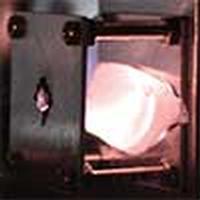当前位置:
X-MOL 学术
›
Adv. Opt. Photon.
›
论文详情
Our official English website, www.x-mol.net, welcomes your
feedback! (Note: you will need to create a separate account there.)
AlGaN photonics: recent advances in materials and ultraviolet devices
Advances in Optics and Photonics ( IF 25.2 ) Pub Date : 2018-01-17 , DOI: 10.1364/aop.10.000043 Dabing Li , Ke Jiang , Xiaojuan Sun , Chunlei Guo
Advances in Optics and Photonics ( IF 25.2 ) Pub Date : 2018-01-17 , DOI: 10.1364/aop.10.000043 Dabing Li , Ke Jiang , Xiaojuan Sun , Chunlei Guo

|
AlGaN-based materials own direct transition energy bands and wide bandgap and thus can be used in high-efficiency ultraviolet (UV) emitters and detectors. Over the past two decades, AlGaN-based materials and devices experienced rapid development. Deep ultraviolet AlGaN-based light-emitting diodes (LEDs) with improved efficiency of 20.3% (at 275 nm) have been produced. An electron beam (EB)-pumped AlGaN-based UV light source at 238 nm, output power of 100 mW, and power conversion efficiency (PCE) of 40% has also been fabricated. UV stimulated emission from AlGaN multiple-quantum-wells laser diodes (LDs) using electrical pumping at room temperature has also been achieved at a wavelength of 336 nm. Compared with GaN-based blue and green LEDs and LDs, the efficiency of AlGaN-based UV LEDs and LDs is lower. Further optimization and improvements in both structure and fabrication are required to realize high-performance devices. In AlGaN-based UV photodetectors (PDs), gain as high as 104 orders of magnitude has been reported using the separated absorption and multiplication region avalanche photodiode structure but is still far from detecting the weak signal, and thus UV single-photon detectors with high detectivity is challenging. Recently, there has been extensive work in the nonlinear optical properties of AlGaN and AlGaN-based passive devices, such as waveguides and resonators. However, how to minimize the scattering and defect-related absorption needs to be further studied. In this review, first, approaches used to grow an AlGaN epilayer and p-type doping are introduced. Second, progress in AlGaN-based UV LEDs, EB-pumped light sources, LDs, PDs, passive devices, and the nonlinear optical properties are presented. Finally, an overview of potential future trends in AlGaN-based materials and UV devices is given.
中文翻译:

AlGaN 光子学:材料和紫外器件的最新进展
AlGaN 基材料具有直接跃迁能带和宽带隙,因此可用于高效紫外 (UV) 发射器和探测器。在过去的二十年中,AlGaN 基材料和器件经历了快速发展。已生产出效率提高 20.3%(275 nm)的深紫外 AlGaN 基发光二极管 (LED)。还制造了电子束 (EB) 泵浦的基于 AlGaN 的紫外光源,波长为 238 nm,输出功率为 100 mW,功率转换效率 (PCE) 为 40%。在室温下使用电泵浦的 AlGaN 多量子阱激光二极管 (LD) 的紫外受激发射也已在 336 nm 波长下实现。与GaN基蓝光和绿光LED和LD相比,AlGaN基UV LED和LD的效率较低。实现高性能器件需要在结构和制造方面进一步优化和改进。在基于 AlGaN 的紫外光电探测器 (PD) 中,使用分离的吸收区和倍增区雪崩光电二极管结构已经报道了高达 104 个数量级的增益,但仍远未检测到弱信号,因此紫外单光子探测器具有高探测具有挑战性。最近,在 AlGaN 和基于 AlGaN 的无源器件(例如波导和谐振器)的非线性光学特性方面进行了广泛的研究。然而,如何最大限度地减少散射和缺陷相关的吸收需要进一步研究。在这篇综述中,首先介绍了用于生长 AlGaN 外延层和 p 型掺杂的方法。二、AlGaN基UV LED、EB泵浦光源、LD、PD、无源器件,以及非线性光学特性。最后,概述了基于 AlGaN 的材料和 UV 器件的潜在未来趋势。
更新日期:2018-01-17
中文翻译:

AlGaN 光子学:材料和紫外器件的最新进展
AlGaN 基材料具有直接跃迁能带和宽带隙,因此可用于高效紫外 (UV) 发射器和探测器。在过去的二十年中,AlGaN 基材料和器件经历了快速发展。已生产出效率提高 20.3%(275 nm)的深紫外 AlGaN 基发光二极管 (LED)。还制造了电子束 (EB) 泵浦的基于 AlGaN 的紫外光源,波长为 238 nm,输出功率为 100 mW,功率转换效率 (PCE) 为 40%。在室温下使用电泵浦的 AlGaN 多量子阱激光二极管 (LD) 的紫外受激发射也已在 336 nm 波长下实现。与GaN基蓝光和绿光LED和LD相比,AlGaN基UV LED和LD的效率较低。实现高性能器件需要在结构和制造方面进一步优化和改进。在基于 AlGaN 的紫外光电探测器 (PD) 中,使用分离的吸收区和倍增区雪崩光电二极管结构已经报道了高达 104 个数量级的增益,但仍远未检测到弱信号,因此紫外单光子探测器具有高探测具有挑战性。最近,在 AlGaN 和基于 AlGaN 的无源器件(例如波导和谐振器)的非线性光学特性方面进行了广泛的研究。然而,如何最大限度地减少散射和缺陷相关的吸收需要进一步研究。在这篇综述中,首先介绍了用于生长 AlGaN 外延层和 p 型掺杂的方法。二、AlGaN基UV LED、EB泵浦光源、LD、PD、无源器件,以及非线性光学特性。最后,概述了基于 AlGaN 的材料和 UV 器件的潜在未来趋势。









































 京公网安备 11010802027423号
京公网安备 11010802027423号